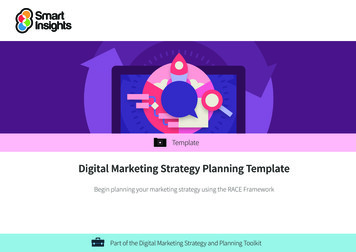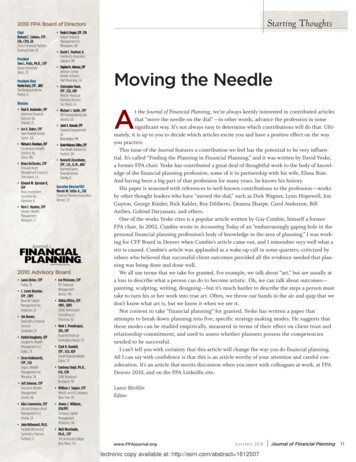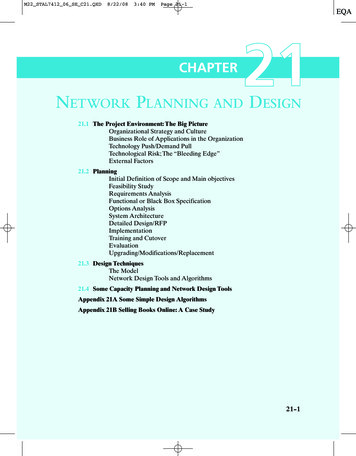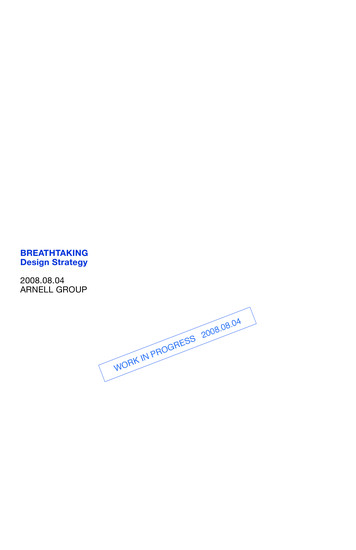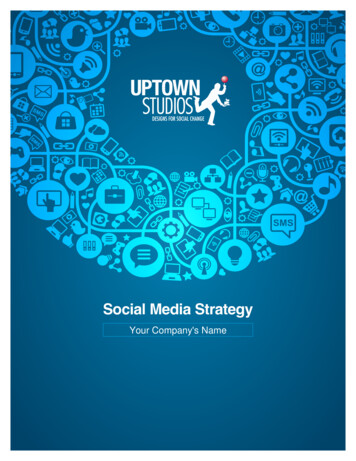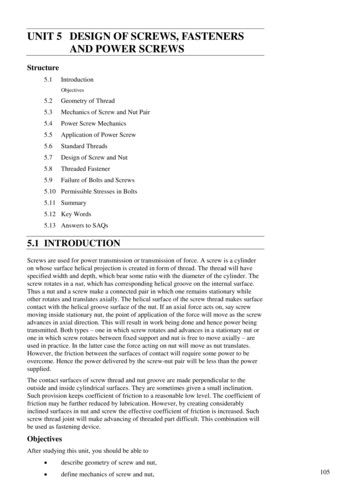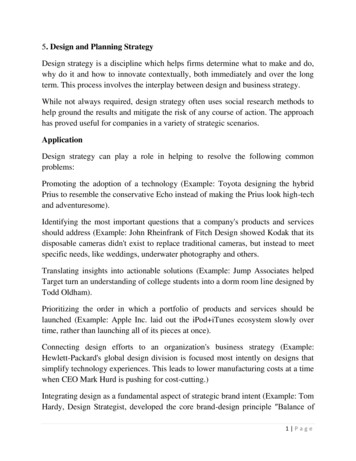
Transcription
5. Design and Planning StrategyDesign strategy is a discipline which helps firms determine what to make and do,why do it and how to innovate contextually, both immediately and over the longterm. This process involves the interplay between design and business strategy.While not always required, design strategy often uses social research methods tohelp ground the results and mitigate the risk of any course of action. The approachhas proved useful for companies in a variety of strategic scenarios.ApplicationDesign strategy can play a role in helping to resolve the following commonproblems:Promoting the adoption of a technology (Example: Toyota designing the hybridPrius to resemble the conservative Echo instead of making the Prius look high-techand adventuresome).Identifying the most important questions that a company's products and servicesshould address (Example: John Rheinfrank of Fitch Design showed Kodak that itsdisposable cameras didn't exist to replace traditional cameras, but instead to meetspecific needs, like weddings, underwater photography and others.Translating insights into actionable solutions (Example: Jump Associates helpedTarget turn an understanding of college students into a dorm room line designed byTodd Oldham).Prioritizing the order in which a portfolio of products and services should belaunched (Example: Apple Inc. laid out the iPod iTunes ecosystem slowly overtime, rather than launching all of its pieces at once).Connecting design efforts to an organization's business strategy (Example:Hewlett-Packard's global design division is focused most intently on designs thatsimplify technology experiences. This leads to lower manufacturing costs at a timewhen CEO Mark Hurd is pushing for cost-cutting.)Integrating design as a fundamental aspect of strategic brand intent (Example: TomHardy, Design Strategist, developed the core brand-design principle ″Balance of1 Page
Reason & Feeling″ for Samsung Electronics, together with rational and emotionalattributes, to guide design language within a comprehensive brand-design programthat inspired differentiation and elevated the company's global image.5.1 Design and PlanningDesignDesign is the creation of a plan or convention for the construction of an object or asystem (as in architectural blueprints, engineering drawings, business processes,circuit diagrams and sewing patterns). Design has different connotations indifferent fields . In some cases the direct construction of an object (as in pottery,engineering, management, cowboy coding and graphic design) is also consideredto be design.More formally design has been defined as follows.(noun) a specification of an object, manifested by an agent, intended to accomplishgoals, in a particular environment, using a set of primitive components, satisfying aset of requirements, subject to constraints;(verb, transitive) to create a design, in anenvironment (where the designer operates)Another definition for design is a roadmap or a strategic approach for someone toachieve a unique expectation. It defines the specifications, plans, parameters, costs,activities, processes and how and what to do within legal, political, social,environmental, safety and economic constraints in achieving that objective.Here, a "specification" can be manifested as either a plan or a finished product, and"primitives" are the elements from which the design object is composed.With such a broad denotation, there is no universal language or unifying institutionfor designers of all disciplines. This allows for many differing philosophies andapproaches toward the subject.The person designing is called a designer, which is also a term used for people whowork professionally in one of the various design areas, usually also specifyingwhich area is being dealt with (such as a fashion designer, concept designer or web2 Page
designer). A designer's sequence of activities is called a design process. Thescientific study of design is called design science.Designing often necessitates considering the aesthetic, functional, economic andsociopolitical dimensions of both the design object and design process. It mayinvolve considerable research, thought, modeling, interactive adjustment, and redesign. Meanwhile, diverse kinds of objects may be designed, including clothing,graphical user interfaces, skyscrapers, corporate identities, business processes andeven methods of designing.PlanningPlanning (also called forethought) is the process of thinking about and organizingthe activities required to achieve a desired goal.Planning involves the creation and maintenance of a plan. As such, planning is afundamental property of intelligent behavior. This thought process is essential tothe creation and refinement of a plan, or integration of it with other plans; that is, itcombines forecasting of developments with the preparation of scenarios of how toreact to them.An important, albeit often ignored aspect of planning, is the relationship it holdswith forecasting. Forecasting can be described as predicting what the future willlook like, whereas planning predicts what the future should look like. Thecounterpart to planning is spontaneous order.5.2 The concept of Corporate StrategyStrategic management analyzes the major initiatives taken by a company's topmanagement on behalf of owners, involving resources and performance in internaland external environments. It entails specifying the organization's mission, visionand objectives, developing policies and plans, often in terms of projects andprograms, which are designed to achieve these objectives, and then allocatingresources to implement the policies and plans, projects and programs. A balancedscorecard is often used to evaluate the overall performance of the business and itsprogress towards objectives. Recent studies and leading management theoristshave advocated that strategy needs to start with stakeholders expectations and use amodified balanced scorecard which includes all stakeholders.3 Page
Strategic management is a level of managerial activity below setting goals andabove tactics. Strategic management provides overall direction to the enterpriseand is closely related to the field of Organization Studies. In the field of businessadministration it is useful to talk about "strategic consistency" between theorganization and its environment or "strategic consistency." According to Arieu"there is strategic consistency when the actions of an organization are consistentwith the expectations of management, and these in turn are with the market and thecontext.""Strategic management is an ongoing process that evaluates and controls thebusiness and the industries in which the company is involved; assesses itscompetitors and sets goals and strategies to meet all existing and potentialcompetitors; and then reassesses each strategy annually or quarterly [i.e. regularly]to determine how it has been implemented and whether it has succeeded or needsreplacement by a new strategy to meet changed circumstances, new technology,new competitors, a new economic environment., or a new social, financial, orpolitical environment.” Strategic Management can also be defined as "theidentification of the purpose of the organisation and the plans and actions toachieve the purpose. It is that set of managerial decisions and actions thatdetermine the long term performance of a business enterprise. It involvesformulating and implementing strategies that will help in aligning the organizationand its environment to achieve organisational goals."Strategic management can depend upon the size of an organization, and theproclivity to change of its business environment. These points are highlightedbelow:A global/transnational organization may employ a more structured strategicmanagement model, due to its size, scope of operations, and need to encompassstakeholder views and requirements.An SME (Small and Medium Enterprise) may employ an entrepreneurial approach.This is due to its comparatively smaller size and scope of operations, as well aspossessing fewer resources. An SME's CEO (or general top management) maysimply outline a mission, and pursue all activities under that mission.4 Page
Whittington (2001) highlighted four approaches to strategic management. Theseare Classical, Processual, Evolutionary and Systemic approaches.Mintzberg stated there are prescriptive (what should be) and descriptive (what is)approaches. Prescriptive schools are "one size fits all" approaches that designate"best practice" while descriptive schools describe how strategy is implemented inspecific contexts.No single strategic managerial method dominates, and remains a subjective andcontext-dependent process.5.3 From the Competitive advantage to the Corporate StrategyCorporate strategy, the overall plan for a diversified company, is both the darlingand the stepchild of contemporary management practice—the darling becauseCEOs have been obsessed with diversification since the early 1960s, the stepchildbecause almost no consensus exists about what corporate strategy is, much lessabout how a company should formulate it.A diversified company has two levels of strategy: business unit (or competitive)strategy and corporate (or companywide) strategy. Competitive strategy concernshow to create competitive advantage in each of the businesses in which a companycompetes. Corporate strategy concerns two different questions: what businesses thecorporation should be in and how the corporate office should manage the array ofbusiness units.Corporate strategy is what makes the corporate whole add up to more than the sumof its business unit parts. The track record of corporate strategies has been dismal. Istudied the diversification records of 33 large, prestigious U.S. companies over the1950–1986 period and found that most of them had divested many moreacquisitions than they had kept. The corporate strategies of most companies havedissipated instead of created shareholder value.The need to rethink corporate strategy could hardly be more urgent. By taking overcompanies and breaking them up, corporate raiders thrive on failed corporate5 Page
strategy. Fueled by junk bond financing and growing acceptability, raiders canexpose any company to takeover, no matter how large or blue chip.Recognizing past diversification mistakes, some companies have initiated largescale restructuring programs. Others have done nothing at all. Whatever theresponse, the strategic questions persist. Those who have restructured must decidewhat to do next to avoid repeating the past; those who have done nothing mustawake to their vulnerability. To survive, companies must understand what goodcorporate strategy is.A Sober PictureWhile there is disquiet about the success of corporate strategies, none of theavailable evidence satisfactorily indicates the success or failure of corporatestrategy. Most studies have approached the question by measuring the stock marketvaluation of mergers, captured in the movement of the stock prices of acquiringcompanies immediately before and after mergers are announced.These studies show that the market values mergers as neutral or slightly negative,hardly cause for serious concern.1 Yet the short-term market reaction is a highlyimperfect measure of the long-term success of diversification, and no selfrespecting executive would judge a corporate strategy this way.Studying the diversification programs of a company over a long period of time is amuch more telling way to determine whether a corporate strategy has succeeded orfailed. My study of 33 companies, many of which have reputations for goodmanagement, is a unique look at the track record of major corporations. (For anexplanation of the research, see the insert “Where the Data Come From.”) Eachcompany entered an average of 80 new industries and 27 new fields. Just over 70%of the new entries were acquisitions, 22% were start-ups, and 8% were jointventures. IBM, Exxon, Du Pont, and 3M, for example, focused on start-ups, whileALCO Standard, Beatrice, and Sara Lee diversified almost solely throughacquisitions.6 Page
5.4 Strategic AlliancesA strategic alliance is an agreement between two or more parties to pursue a set ofagreed upon objectives need while remaining independent organizations. This formof cooperation lies between Mergers & Acquisition M&A and organic growth.Partners may provide the strategic alliance with resources such as products,distribution channels, manufacturing capability, project funding, capital equipment,knowledge, expertise, or intellectual property. The alliance is a cooperation orcollaboration which aims for a synergy where each partner hopes that the benefitsfrom the alliance will be greater than those from individual efforts. The allianceoften involves technology transfer (access to knowledge and expertise), economicspecialization, shared expenses and shared risk.Various terms have been used to describe forms of strategic partnering. Theseinclude ‘international coalitions’ (Porter and Fuller, 1986), ‘strategic networks’(Jarillo, 1988) and, most commonly, ‘strategic alliances’. Definitions are equallyvaried. An alliance may be seen as the ‘joining of forces and resources, for aspecified or indefinite period, to achieve a common objective’.There are seven general areas in which profit can be made from building alliances.One typology of strategic alliances conceptualizes them as horizontal, vertical orinter-sectoral:Horizontal strategic alliance: Strategic alliance characterized by the collaborationbetween two or more firms in the same industry, e.g. the partnership between SinaCorp and Yahoo in order to offer online auction services in China;Vertical strategic alliances: Strategic alliance characterized by the collaborationbetween two or more firms along the vertical chain, e.g. Caterpillar's provision ofmanufacturing services to Land Rover;Intersectoral strategic alliances: Strategic alliance characterized by thecoll
Reason & Feeling″ for Samsung Electronics, together with rational and emotional attributes, to guide design language within a comprehensive brand-design program that inspired differentiation and elevated the company's global image. 5.1 Design and Planning Design Design is the creation of a plan or convention for the construction of an object or a system (as in architectural blueprints .
